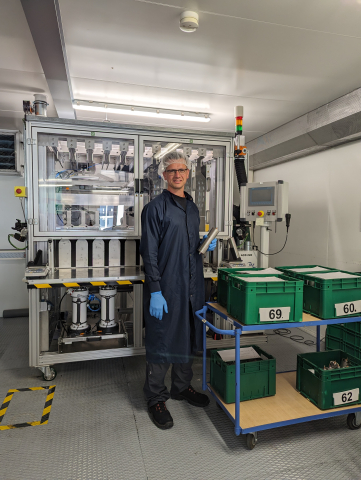The quality of a battery cell depends on the individual process steps in its production - including the precise filling with electrolyte. Karsten Weinrich, production manager of EAS Batteries GmbH, has answered four questions about the vacuum technology of EAS electrolyte filling:
How does the electrolyte filling process affect the quality of the battery cell?
"The dosing of the electrolyte directly influences the performance of the cell. If too little electrolyte enters the cell, dry spots occur. They reduce the capacity because no lithium ion exchange takes place here. Too much electrolyte, however, leads to a higher fire load, unnecessary waste and increases both costs and weight. The optimal dosing provides for the amount of electrolyte that can be absorbed by the active material and the separator of the cell, as well as a reservoir of free electrolyte determined by a CAD model for consumption within the cell. The advantage in our manufacturing is that we fill each cell individually and to the gram with the metering piston pump."
To what extent is such individual filling scalable?
"The manufacturer of our filling station has successfully driven the further development of the system. It may be now scalable and can be automated. For us, the exchange on this is important, as we expect investments in the expansion of our production capacities. Since we manufacture large-format round cells, it is all the more important that they have maximum performance and a long service life due to their fields of application in the maritime industry, NRMM (Non-Road Mobile Machinery) or aerospace. It is also essential for pricing that we don't produce unnecessary waste with such a high material input."
How does the electrolyte filling with vacuum pump work?
"The vacuum pump draws the air out of the cell until the pressure in the cell is a few millibars. Then the metering piston pump pushes the electrolyte into the cell at a pressure of several bar. The overpressure increases the speed. The electrodes absorb the electrolyte like a sponge. As soon as the pressure in the cell has dropped to just below atmospheric pressure, the filling needle rises again. Our electrolyte filling system was customised according to our wishes. For example, we have increased the filling speed by tempering the electrolyte. Due to the improved flowability, it can be filled more quickly when warmed up."

What is the added ecological value of this vacuum technology?
"The filling technology that EAS uses is absolutely clean and energy-efficient. Due to the slight vacuum at the end of the filling process, the electrolyte remains completely in the cell. None of the corrosive substances get out - in contrast to other common filling methods, such as the pressure chamber method. This means that we do not need a washing line, no drying and no treatment of the rinsing water. This saves both space and energy. This is also an important aspect with regard to possible scaling."